
I reviewed Cantaloop: Book 1 (Breaking Into Prison) back here and absolutely loved it! It made the top spot on our Top 10 Cooperative Games of 2021!
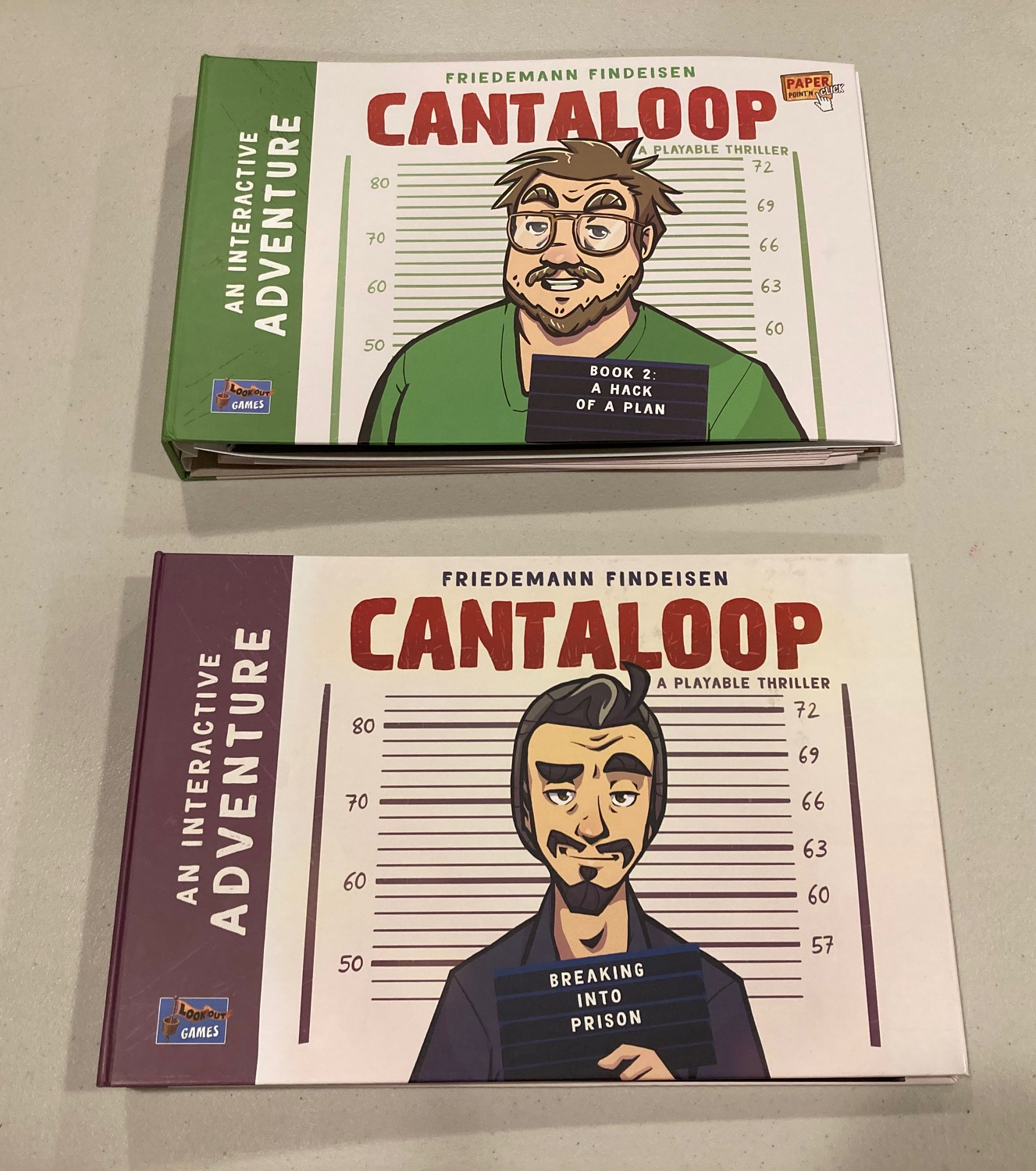
When I heard the newest book was due to come out, I made sure to preorder it as soon as possible! It arrived a few weeks ago and I finally got a chance to check this out!
Get the Errata!
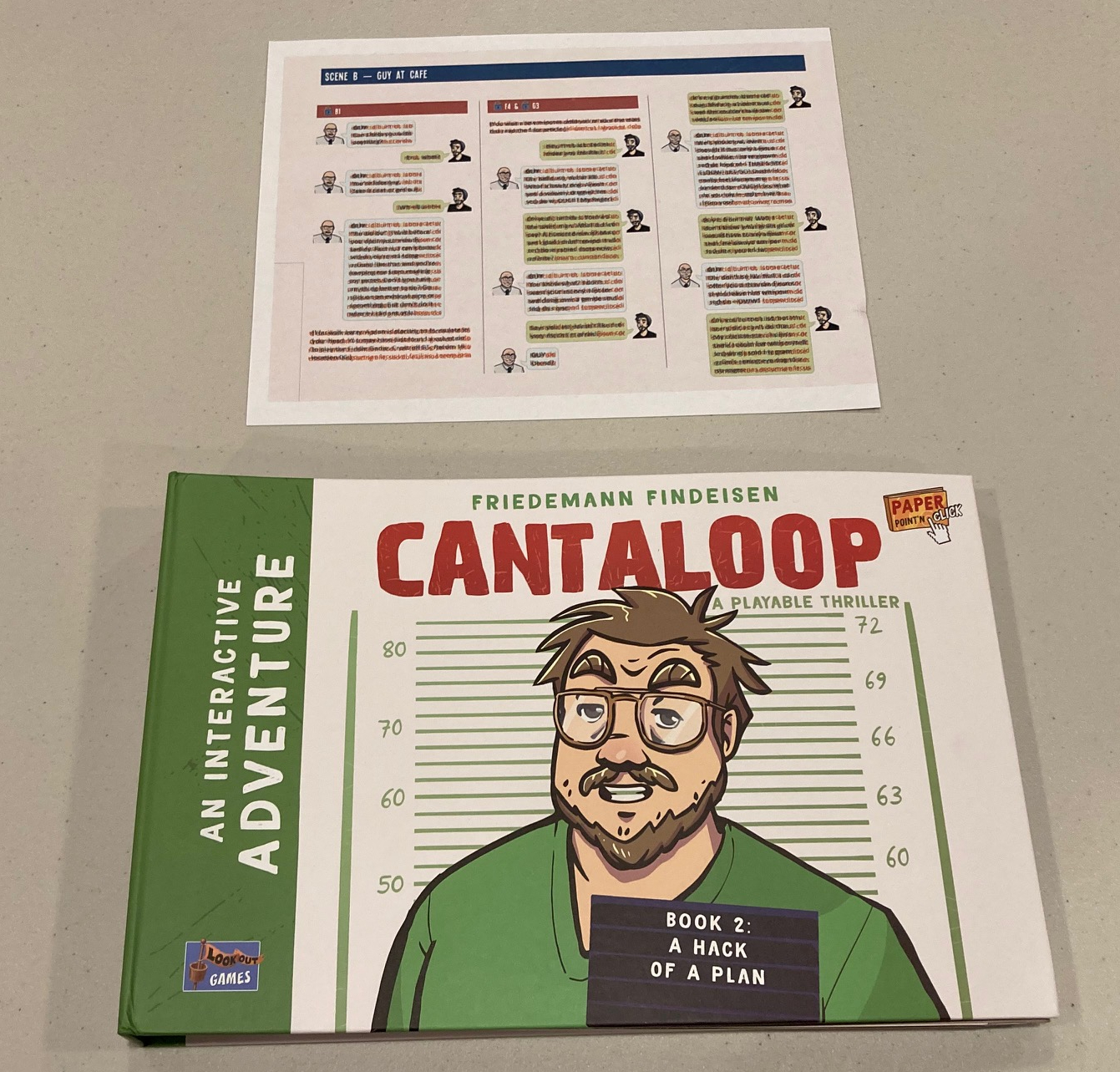
If you have the First Edition, Conversation B needs a replacement page. Make sure you get that before you play! I did! I printed the extra page out and put in in my book.
See more information here: https://boardgamegeek.com/thread/2839863/english-typo-warning
Unboxing

This is pretty much like the original Cantaloop: 3 pouches with 72 cards total, another larger pouch with the map, combiner sheet, progress checkoff, and the red acetate.
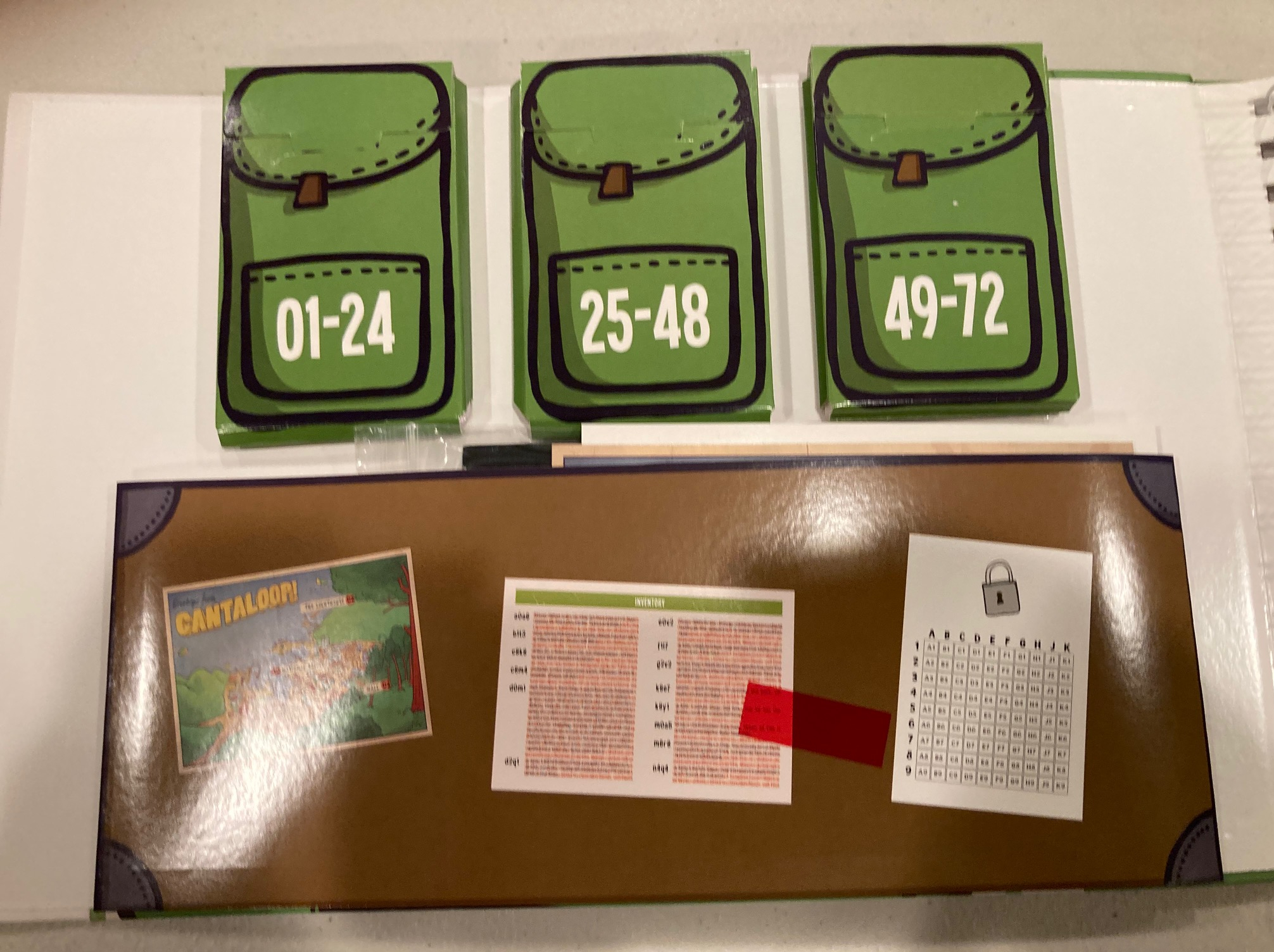

The game also includes a sheet of “progress point” that you need to mark off (E1, F1, G2, etc) to show your progress through the game. The first thing I did (well, the second after I printed off the errata) was copy the progress sheet so I could play this again without harming the original sheet.


As you can see, this is one of those games that uses the red acetate to “reveal” text in the sheets.

The book itself is full of “hidden” clues you will have to reveal as you explore.
Overall, the game looks consistent: it has a silly sense of humor and the art and components belie that as well.
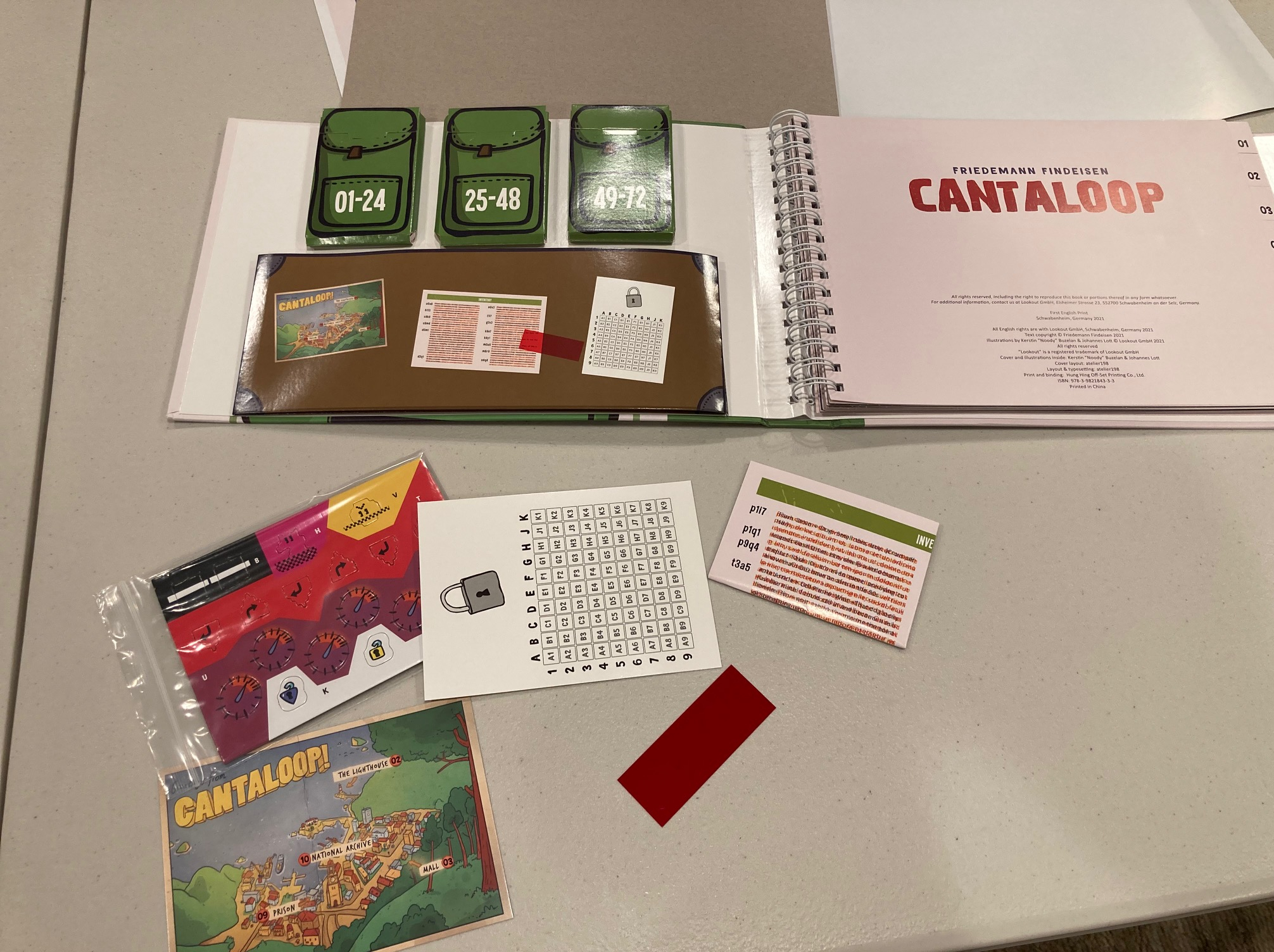
Introduction and Gameplay
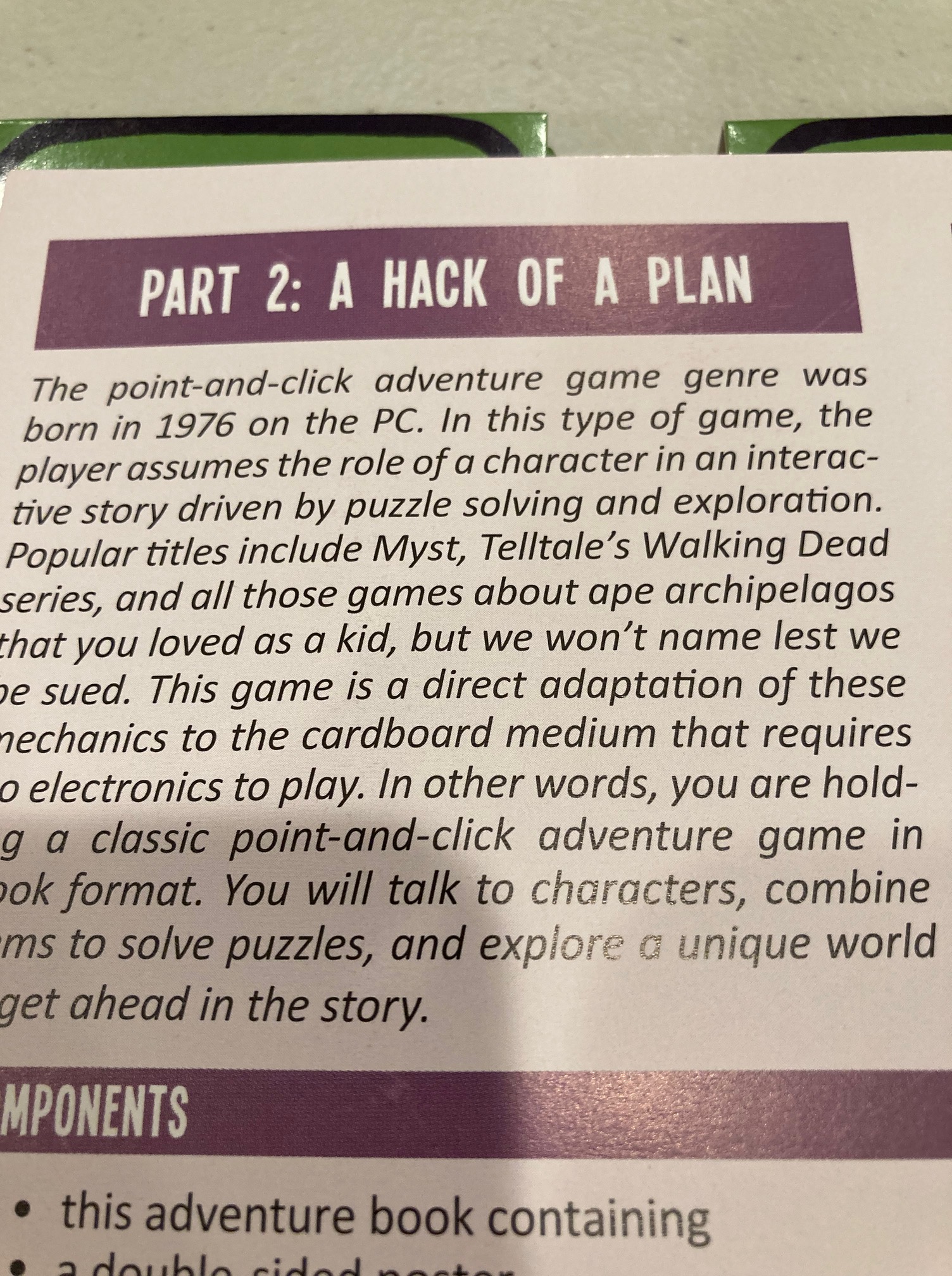
So, this is a “point-and-click” adventure book game. What does that mean? See the text above for one view, but essentially, you explore, talk to characters, try to do things and combine objects to get stuff done. In this game, exploration and talking means turning to a page and following the rules there.
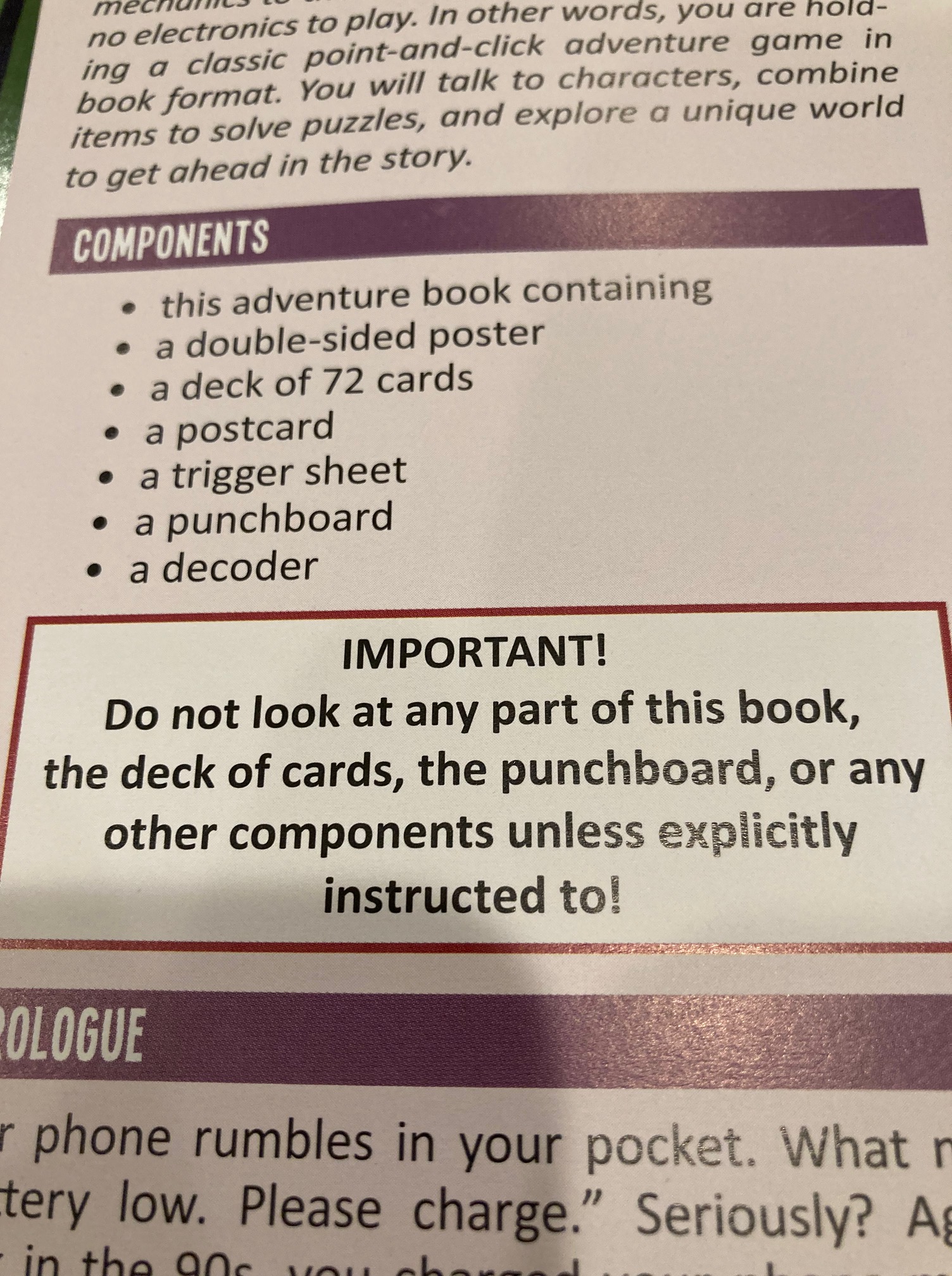
The red acetate keeps most secrets hidden, but the game warns you to be careful. In general, the rules get you playing and understanding the mechanisms right away.

Trilogy

This is Part Two of a Three part story. If you haven’t played the original, you don’t HAVE to, it just makes the story make more sense. I have played the original about a year ago (so I forgot a lot of it), but once I started it playing, it all came back. I also didn’t need to have played the original: it just makes it easier to get into the story.
Much Like The Original

Cantaloop: Book 2 is very much much like Cantaloop: Book 1. Seriously: you can take a look at our original review of Cantaloop here and almost everything we said still applies: it has a sense of humor, the art is consistently silly through-out, there’s a lot of page turning, there’s a lot of looking at text through red acetate, and there’s a lot of puzzles … some easy, some hard. Generally, it’s great!

One thing I want to give props to! One of my only complaints of the first book was that I thought the paper quality wasn’t great: I was afraid I’d tear the pages as I turned through everything so much. The newer edition has better paper quality! This is a great improvement because you turn the pages so much!
But how’s the game play?
A Dirty Secret
I originally compared Cantaloop to the Monkey Island series of video games back in my original review (see here). This analogy seems even more apt in light of the new Cantaloop: Book 2. Why’s that you ask? Because I have a dirty little secret about the Monkey Island series! As much as I think the first Secret of Monkey Island is perfect, and as much as I adore the first 90% of the sequel LeChuck’s Revenge, I hated the last 10% of the game. A lot of Ron GIlbert’s games seem to do that do me: I love the first 90% then hate the last 10%. In Psychonauts, the first 90% of the game is exploring an interesting world populated by some fascinating kids, but the last 10% is just a joystick buster. No fun! In LeCheck’s Revenge, the puzzles in the first 90% are great! The last 10% is so frustrating as LeChuck randomly just resets you back to a save point over and over and over and over …
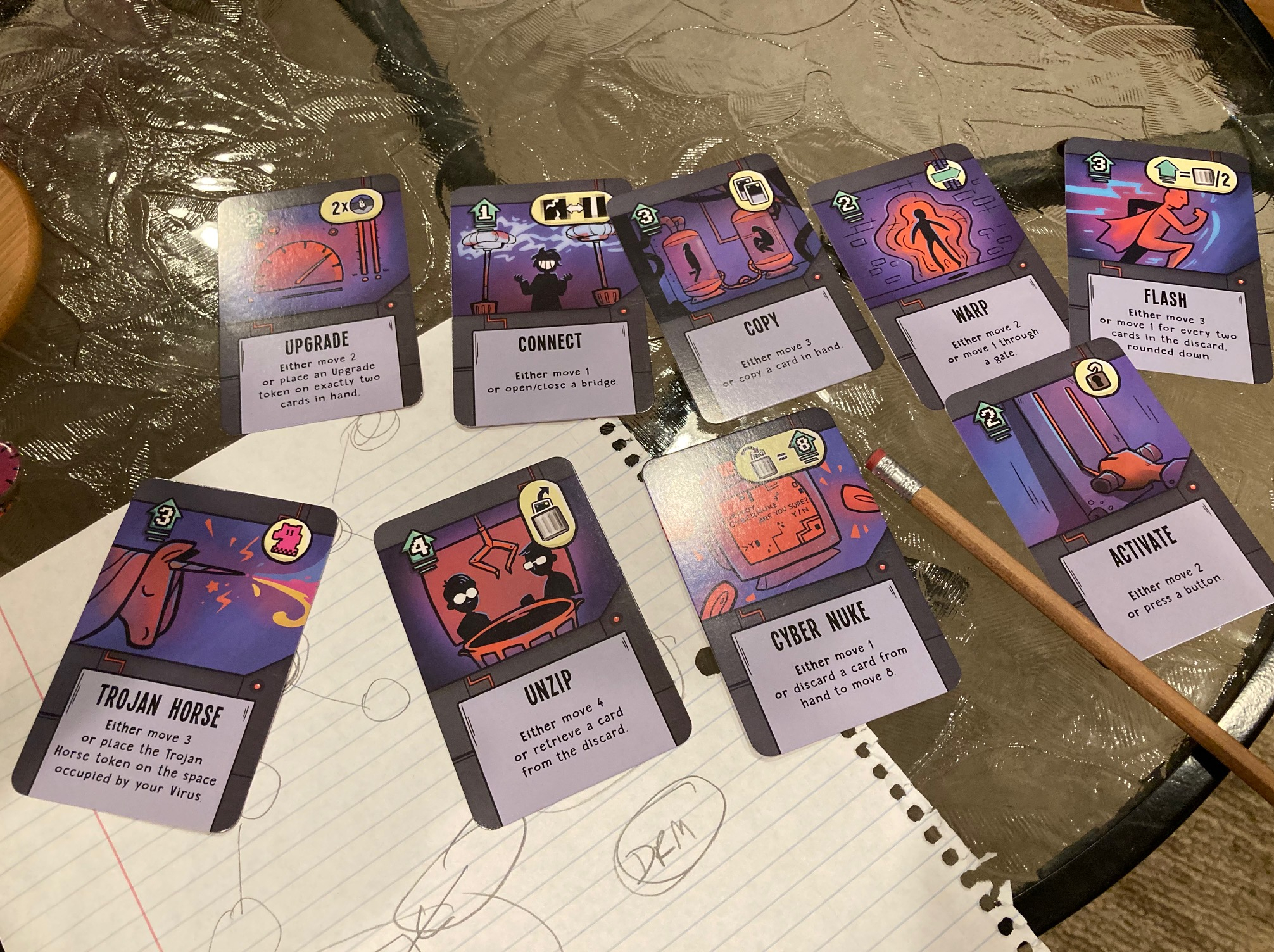
And I had the a problem with Cantaloop: Book 2. I hated the how the ending played out. The game sets-up these more and more challenging programming puzzles: players uses some cards to move “things” about a virtual world—they program the movement. The first 8 or so puzzles are fun and challenging, but then it just stops working as a mechanic.
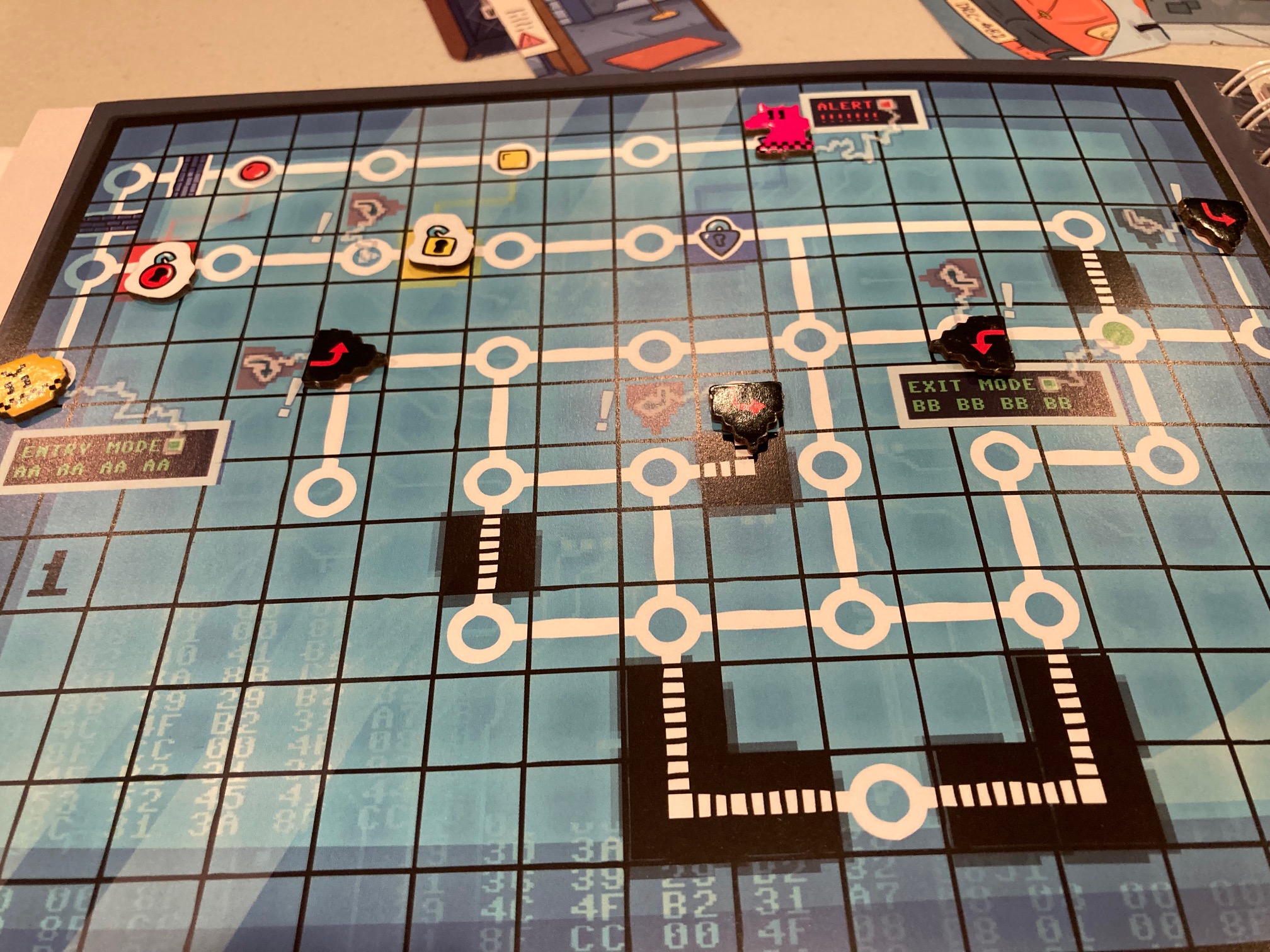
The initial idea is interesting: set-up all these programming puzzles to move further along in the book! See above. The first few are fun, the next few are challenging, and then … you just get tired of them. The last 90% of the game was miserable because that’s all the last 90% was: these programming puzzles. And they had stopped being fun. I stopped caring and just “solved the puzzle” using the hint (well, even worse, I just cheated and assumed I moved forward). I want to say it was puzzle E2 that I stopped caring.
Problems With The Programming Puzzles

There were several problems with these programming puzzles in the game. At its core, these puzzles were just “put cards in order to move pieces to solve a puzzle”—they kept building and building and building on the basic premise to make it harder and harder. This build-up wasn’t an issue per se, but there were several problems around it.
- It’s too hard to look back and see the “last set of rules”. Because Cantaloop is all about the red acetate, you have to look back and re-read the rules again—and that’s annoying with the red acetate.
- The rules are NOT on same pages as you are playing. Every time, the rules are NOT on the same page as your playing, which means if there are questions, you have to page BACKWARDS and disturb your board set-up (you have to put pieces on the pages). The rules needed to be either (a) on the same viewable pages or (b) on a separate sheet you could refer to
- The rules were poorly specified. I attempted to reverse-engineer and figure out what the rules were FROM the solutions. The rules for the programming puzzles should have been better specified. After seeing how many questions I had and directions I couldn’t decipher, I didn’t want to try to solve it! There were too many rules to get wrong! (I attempt to fix some of that in the rules clarifications below). There was no FAQ.
- The mechanism grew tiresome. There were 14 of these programming puzzles! That same type of puzzle over and over grew very tiresome.
- The state space is huge. By the time you get to the later puzzles, the amount of ways the cards could be played together is enormous, and you just have to stumble your way into the right solution. There might be some intuition, but generally the solution is to “keep trying over and over”
- The pieces of the puzzle are fiddly and maintenance-heavy. In order to keep trying over and over, you have to do a lot of maintenance: get one wrong rule or forget a movement, and invalidate your solution which involved moving so many pieces around. It was agony in the later ones to have to move so many pieces
All together, I stopped caring about solving the programming puzzles at about checkpoint E2.
Rules Clarifications

I spent an entire morning going through the proposed solution (from the back of the book) to the E2 puzzle. There were so many questions I had about how things worked that I had to reverse-engineer the solution. Presented below is what I think the under-specified rules are (based on the solution given by the book) what the interpretations for these rules are.
- Do Tracers start ON the board or OFF the board? Although this seems like a silly question, take a look at the notation: the tracer could start OFF the board, with it’s first movement being to appear in the space it’s connected to. The Tracer could also start ON the board, so when it moves, it moved away from its first space. This question makes a difference of 1 extra space, and that can be huge.
The Ruling: Tracers start ON the board. See picture above. I think that was clear from the solution.
2. Do you have to use all of your cards?
The rule, somewhat obscured by the notion of elegance (some of use believe that fewer lines of code are more elegant), is highlighted in the picture above.
The Ruling: You always have to use all of your cards! It’s very clearly stated.

3. Do Tracers obey Bridges and Gates? I am not sure, but based on my running the puzzle solution, I think they respect bridges but ignore gates? At least that’s what running the puzzle solution seemed to imply.
The Ruling: Tracers respect bridges but ignore gates. I think? Not clear?

4. How do Tracers handle ends?
It seemed to not come up once you get the rules right, but I think if a Tracer hits the and and can’t move, then it just turns around. Still needs to be specified I think.
The Ruling: Tracers turn around: they move one space in and one space out.

5. The tracers, on every turn, have to MOVE (M), DETERMINE DIRECTION (D), REORIENT THEMSELVES. (R) In what order does this happen? This is a huge deal which I spent an hour trying to make sure I understood. You need to understand this! The real question: when you move tracers, do you MDR or DRM?
If you MDR, then the above is the interpretation of the movement for the Tracer. (M) Move in the direction of your orientation (straight-up), (D) Determine direction to move (straight-up), (R) Reorient arrow in that new direction.
If you DRM, then the above is the interpretation for the Tracer. (D) Determine direction to move (to the right), (R) Reorient (to the right), (M) move to the right.
It makes a BIG DIFFERENCE, right? After running through the solution, the answer is clear: MDR. I am actually pretty sure on this: I ran through this solution over and over.
The ruling: MDR (Move in the direction of the arrow, the Determine where you’ll go next move, then reorient in that direction). Pretty confident in this.

6. How do the Tracers follow the dotted lines?
The ruling: it seems that moving over the lock allows you to move. Veru unclear, but it didn’t seem to affect my play. So I’m still not sure.
There were TOO MANY QUESTIONS for me to even hope I got the rules right. I had to reverse-engineer the solution to this to even have a hope of getting this right. The book really needed many more clarifications, pictures, and examples of how things worked … maybe some cards showing this?
It was after this I sort of gave up. The rules were poorly stated, so I felt like I had no chance of getting the puzzles right anyways, so I stopped caring for the programming puzzles.
Where Does That Leave Us?

Cantaloop: Book 2 (A Hack of a Plan) was great … right up until I hit programming puzzle E2. It was the 8th programming puzzle, and I was just getting tired of the programming puzzles. By the time I got the E2, I was “done” trying to interpret the poorly stated rules. Luckily, those puzzles come near the end of the game: The only thing left in the game was 4 more programming puzzles. So, to finish up, I simply “pretended” to do them and then I moved on, reading text as I went.
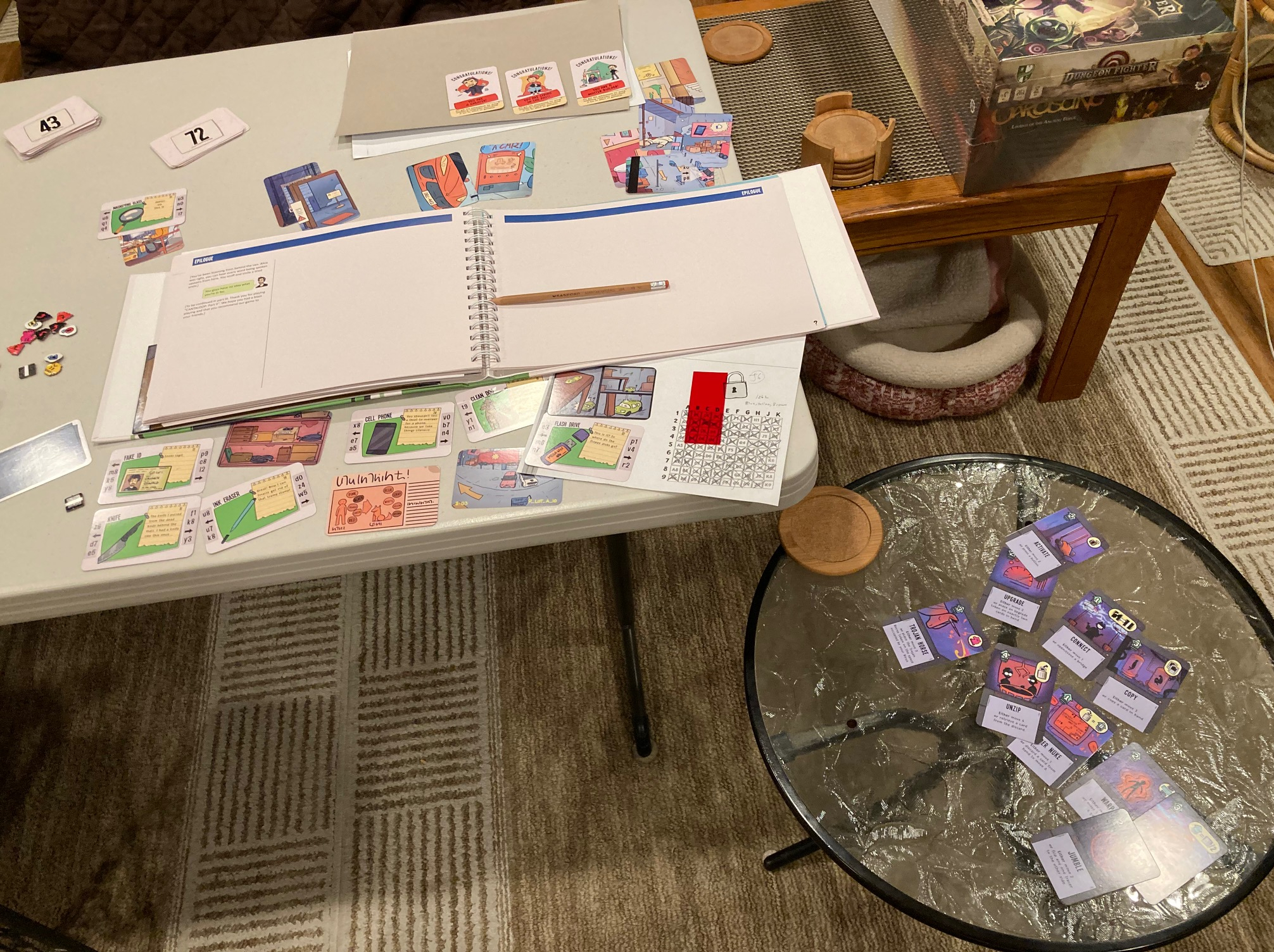
And the end game had some interesting story fragments that re-engaged me: I want to see what happens in the next book!!
There is an easy mode in the game, but it’s not clear it would have skipped the last 4 annoying programming puzzles. If this were a video game, I would have looked up the solution on the internet and just finished off the last 4 puzzles just to get to the endgame and the conclusion.
So, I still care about the characters Hook and Fly and Alice and what happens to them. I do want to get the next Cantaloop book. So, here’s my recommendation for you:
- If you want to solve ALL the puzzles, make sure you look online for a FAQ or clarification before attempting them. I admit that a lot of my “I stopped caring” was because there were too many things underspecified. Find out all the rules, then maybe those puzzles will be more fun!
- If you want a lighter, more fun game, solve everything up to programming puzzle E2, and then just ignore the final 4 programming puzzles: pretend you solved all the programming puzzles as you go so you can see the end game.
Let’s be clear: except for the last 4 or 5 programming puzzles, I had a great time playing this! There’s a lot of that fun that came with the point-and-click adventure solving! All the humor and fun of the first Cantaloop was still there! The programming puzzle pieces will easily be the most controversial pieces of this game: you know right away if that is something you will like or not.
Conclusion

Cantaloop: Book 1 (Breaking Into Prison) made the Top Spot on my Top 10 Cooperative Games of 2021! I gave it a 9 out of 10! I was very excited to get the next book Cantaloop: Book 2(A Hack of a Plan). I freely admit that I was disappointed by this somewhat: the programming puzzles had many problems and ended up detracting from all the goodness that is in Cantaloop: Book 2! If you want the super hard programming puzzles, make sure you find all the proper FAQs and clarifications before you attempt them. Otherwise, ignore all the programming puzzles after E2 and just concentrate on all the goodness of the rest of the game.
If we take Cantaloop: Book 2 as-is, I’d probably give this a 6/10. But, if we ignore the programming puzzles after E2 and just enjoy the rest of the story and experience for what it is, I’d give this a 7.5/10. There is a lot of humor and puzzles to like here.
I am still looking forward to Cantaloop: Book 3. Book 2 won’t make the top spot of my Top 10 Cooperative Games of 2022 (like Book 1 did in 2021), but Book 2 will still make the Top 10 overall. Weirdly, Book 2 could also make my Top 10 Disappointments of 2022 at the same time it makes my Top 10. I hope that makes sense.







6 thoughts on “A Review of Cantaloop: Book 2 (A Hack of a Plan)”